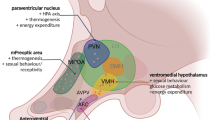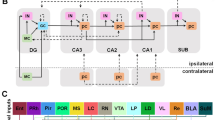Abstract
Growth hormone (GH) has been implicated in a variety of brain functions, including neural development, cognition, and neuroprotection. The biological effects of GH are known to rely on the binding of GH to the GH receptor (GHR), yet the resulting signals in the brain remain poorly understood. The present study investigated the effects of hippocampal infusions of recombinant GH and a GHR antagonist on the expression of immediate early genes (IEGs) and behavioral responses in mice. The infusions induced differential expression of Arc, Nr4a1, and Npas4 mRNAs among the IEGs. The infusions also elicited differential behavioral responses, such as varied levels of spontaneous locomotion, self-grooming, and frequency of access to the corner fields in the open-field test. Polynomial regression analyses and canonical discriminant analyses between gene expression and behavioral changes demonstrated that the expression level of Arc mRNA was strongly correlated with locomotor activity level (r = 0.71 and 0.92 on days 8 and 10, respectively) and that the correlation was completely discriminable between drugs (error rate = 0 %). This analysis also revealed that a decrease in Npas4 mRNA was negatively correlated with the number of corner accesses (r = −0.63) and that this correlation was partially discriminable between drugs (error rate = 16.67 %). Taken together, these results suggest that the GH–GHR complex modulates Arc and Npas4 signaling, which affects spontaneous locomotor and exploratory behaviors.




Similar content being viewed by others
Abbreviations
- Arc :
-
Activity-regulated cytoskeletal-associated protein
- CNS:
-
Central nervous system
- Fos :
-
FBJ osteosarcoma oncogene
- GAPDH:
-
Glyceraldehyde-3-phosphate dehydrogenase
- GH:
-
Growth hormone
- GHR:
-
Growth hormone receptor
- IEGs:
-
Immediate early genes
- Npas4 :
-
Neuronal PAS domain protein
- Nr4a1:
-
Nuclear receptor subfamily 4, group A, member 1
- qRT-PCR:
-
Quantitative real-time polymerase chain reaction
- rGH:
-
Human GH recombinant
- TLE:
-
Temporal lobe epilepsy
References
Akiyama K, Ishikawa M, Saito A (2008) mRNA expression of activity-regulated cytoskeleton-associated protein (arc) in the amygdala-kindled rats. Brain Res 1189:236–246
Becker AJ, Chen J, Zien A, Sochivko D, Normann S, Schramm J et al (2003) Correlated stage- and subfield-associated hippocampal gene expression patterns in experimental and human temporal lobe epilepsy. Eur J Neurosci 18:2792–2802
Beranek L, Hajdu I, Gardi J, Taishi P, Obál Fn Jr, Krueger JM (1999) Central administration of the somatostatin analog octreotide induces captopril-insensitive sleep responses. Am J Physiol 277:R1297–R1304
Bozzi Y, Dunleavy M, Henshall DC (2011) Cell signaling underlying epileptic behavior. Front Behav Neurosci 5:45
Castro JE, Varea E, Márquez C, Cordero MI, Poirier G, Sandi C (2010) Role of the amygdala in antidepressant effects on hippocampal cell proliferation and survival and on depression-like behavior in the rat. PLoS One 5:e8618
Deijen JB, de Boer H, Blok GJ, van der Veen EA (1996) Cognitive impairments and mood disturbances in growth hormone deficient men. Psychoneuroendocrinology 21:313–322
Donahue CP, Kosik KS, Shors TJ (2006) Growth hormone is produced within the hippocampus where it responds to age, sex, and stress. Proc Natl Acad Sci USA 103:6031–6036
Ekinci O, Titus JB, Rodopman AA, Berkem M, Trevathan E (2009) Depression and anxiety in children and adolescents with epilepsy: prevalence, risk factors, and treatment. Epilepsy Behav 14:8–18
Elliott RC, Miles MF, Lowenstein DH (2003) Overlapping microarray profiles of dentate gyrus gene expression during development- and epilepsy-associated neurogenesis and axon outgrowth. J Neurosci 23:2218–2227
Escorihuela RM, Fernández-Teruel A, Gil L, Aguilar R, Tobeña A, Driscoll P (1999) Inbred Roman high- and low-avoidance rats: differences in anxiety, novelty-seeking, and shuttlebox behaviors. Physiol Behav 67:19–26
Ettinger AB, Weisbrot DM, Krupp LB, Coyle PK, Jandorf L, Devinsky O (1998) Fatigue and depression in epilepsy. J Epilepsy 11:105–109
Fattore L, Piras G, Corda MG, Giorgi O (2009) The Roman high- and low-avoidance rat lines differ in the acquisition, maintenance, extinction, and reinstatement of intravenous cocaine self-administration. Neuropsychopharmacology 34:1091–1101
Flood WD, Moyer RW, Tsykin A, Sutherland GR, Koblar SA (2004) Nxf and Fbxo33: novel seizure-responsive genes in mice. Eur J Neurosci 20:1819–1826
Glauser TA (2004) Effects of antiepileptic medications on psychiatric and behavioral comorbidities in children and adolescents with epilepsy. Epilepsy Behav 5:S25–S32
Goosens KA, Maren S (2001) Contextual and auditory fear conditioning are mediated by the lateral, basal, and central amygdaloid nuclei in rats. Learn Mem 8:148–155
Gorter JA, van Vliet EA, Aronica E, Breit T, Rauwerda H, Lopes da Silva FH et al (2006) Potential new antiepileptogenic targets indicated by microarray analysis in a rat model for temporal lobe epilepsy. J Neurosci 26:11083–11110
Hale MW, Hay-Schmidt A, Mikkelsen JD, Poulsen B, Shekhar A, Lowry CA (2008) Exposure to an open-field arena increases c-Fos expression in a distributed anxiety-related system projecting to the basolateral amygdaloid complex. Neuroscience 155:659–672
Harvey S, Hull K (2003) Neural growth hormone: an update. J Mol Neurosci 20:1–13
Hawk JD, Abel T (2011) The role of NR4A transcription factors in memory formation. Brain Res Bull 85:21–29
Herrington J, Carter-Su C (2001) Signaling pathways activated by the growth hormone receptor. Trends Endocrinol Metab 12:252–257
Hevroni D, Rattner A, Bundman M, Lederfein D, Gabarah A, Mangelus M et al (1998) Hippocampal plasticity involves extensive gene induction and multiple cellular mechanisms. J Mol Neurosci 10:75–98
Hitiris N, Mohanraj R, Norrie J, Sills GJ, Brodie MJ (2007) Predictors of pharmacoresistant epilepsy. Epilepsy Res 75:192–196
Hodge C, Liao J, Stofega M, Guan K, Carter-Su C, Schwartz J (1998) Growth hormone stimulates phosphorylation and activation of elk-1 and expression of c-fos, egr-1, and junB through activation of extracellular signal-regulated kinases 1 and 2. J Biol Chem 273:31327–31336
Homberg JR, van den Akker M, Raasø HS, Wardeh G, Binnekade R, Schoffelmeer AN et al (2002) Enhanced motivation to self-administer cocaine is predicted by self-grooming behavior and relates to dopamine release in the rat medial prefrontal cortex and amygdala. Eur J Neurosci 15:1542–1550
Kato K, Masa T, Tawara Y, Kobayashi K, Oka T, Okabe A et al (2001) Dendritic aberrations in the hippocampal granular layer and the amygdalohippocampal area following kindled-seizures. Brain Res 901:281–295
Kato K, Suzuki M, Kanno H, Sekino S, Kusakabe K, Okada T et al (2009) Distinct role of growth hormone on epilepsy progression in a model of temporal lobe epilepsy. J Neurochem 110:509–519
Lamberts SW, Verleun T, Hofland L, Del Pozo E (1987) A comparison between the effects of SMS 201–995, bromocriptine and a combination of both drugs on hormone release by the cultured pituitary tumour cells of acromegalic patients. Clin Endocrinol (Oxf) 27:11–23
Laron Z (2009) Growth hormone and insulin-like growth factor I: effects on the brain. In: Arnold A et al (eds) Hormones, brain and behavior. Academic Press, San Diego, pp 2449–2470
Lukasiuk K, Kontula L, Pitkänen A (2003) cDNA profiling of epileptogenesis in the rat brain. Eur J Neurosci 17:271–279
Lyons MR, West AE (2011) Mechanisms of specificity in neuronal activity-regulated gene transcription. Prog Neurobiol 94:259–295
Nedivi E, Hevroni D, Naot D, Israeli D, Citri Y (1993) Numerous candidate plasticity-related genes revealed by differential cDNA cloning. Nature 363:718–722
Nyberg F (2000) Growth hormone in the brain: characteristics of specific brain targets for the hormone and their functional significance. Front Neuroendocrinol 21:330–348
Okuno H (2011) Regulation and function of immediate-early genes in the brain: beyond neuronal activity markers. Neurosci Res 69:175–186
Perini GI, Tosin C, Carraro C, Bernasconi G, Canevini MP, Canger R et al (1996) Interictal mood and personality disorders in temporal lobe epilepsy and juvenile myoclonic epilepsy. J Neurol Neurosurg Psychiatry 61:601–605
Plath NL, Ohana O, Dammermann B, Errington ML, Schmitz D, Gross C et al (2006) Arc/Arg3.1 is essential for the consolidation of synaptic plasticity and memories. Neuron 52:437–444
Ploski JE, Monsey MS, Nguyen T, DiLeone RJ, Schafe GE (2011) The Neuronal PAS Domain Protein 4 (Npas4) is required for new and reactivated fear memories. PLoS One 6:e23760
Ramamoorthi K, Fropf R, Belfort GM, Fitzmaurice HL, McKinney RM, Neve RL, Otto T, Lin Y (2011) Npas4 regulates a transcriptional program in CA3 required for contextual memory formation. Science 334:1669–1675
Ramsey MM, Weiner JL, Moore TP, Carter CS, Sonntag WE (2004) Growth hormone treatment attenuates age-related changes in hippocampal short-term plasticity and spatial learning. Neuroscience 129:119–127
Stanfield JP (1960) The blood supply of the human pituitary gland. J Anat 94:257–273
Tang Y, Lu A, Aronow BJ, Wagner KR, Sharp FR (2002) Genomic responses of the brain to ischemic stroke, intracerebral haemorrhage, kainate seizures, hypoglycemia, and hypoxia. Eur J Neurosci 15:1937–1952
Tournier BB, Steimer T, Millet P, Moulin-Sallanon M, Vallet P, Ibaaemorrhageal (2013) Innately low D2 receptor availability is associated with high novelty-seeking and enhanced behavioural sensitization to amphetamine. Int J Neuropsychopharmacol 16(8):1819–1834
van Dam PS, Aleman A, de Vries WR, Deijen JB, van der Veen EA, de Haan EHF, Koppeschaar HPF (2000) Growth hormone, insulin-like growth factor I and cognitive function in adults. Growth Horm IGF Res Suppl B:S69–S73
Vazquez B, Devinsky O (2003) Epilepsy and anxiety. Epilepsy Behav 4:S20–S25
Witter MP, Amaral DG (2004) Hippocampal formation. In: Paxinos G (ed) The rat nervous system, 3rd edn. Academic Press Inc., San Diego, pp 635–704
Acknowledgments
This work was supported by grants from Kyoto Sangyo University Research Grants (E1106), the Ministry of Education, Culture, Sports, Science and Technology (17580260), and Core Research for Evolutional Science and Technology (CREST) of the Japan Science and Technology Agency (JST). The funding source had no role in study design/concept, data collection/analysis/interpretation, and manuscript preparation/submission. We appreciate Dr. Takeo Yoshikawa and Dr. Kazuyuki Yamada, Brain Science Institute, RIKEN, for their discussions regarding the manuscript, and Dr. Yoshiaki Nakayama and Dr. Akira Kurosaka for generously allowing us to use their dark-light box.
Conflict of interest
The authors declare that they have no conflict of interest.
Author information
Authors and Affiliations
Corresponding author
Electronic supplementary material
Below is the link to the electronic supplementary material.
Rights and permissions
About this article
Cite this article
Srimontri, P., Hirota, H., Kanno, H. et al. Infusion of growth hormone into the hippocampus induces molecular and behavioral responses in mice. Exp Brain Res 232, 2957–2966 (2014). https://doi.org/10.1007/s00221-014-3977-y
Received:
Accepted:
Published:
Issue Date:
DOI: https://doi.org/10.1007/s00221-014-3977-y




